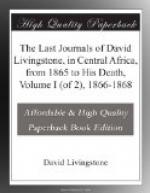20th February, 1867.—I told the chief before starting that my heart was sore, because he was not sending me away so cordially as I liked. He at once ordered men to start with us, and gave me a brass knife with ivory sheath, which he had long worn, as a memorial. He explained that we ought to go north as, if we made easting, we should ultimately be obliged to turn west, and all our cloth would be expended ere we reached the Lake Tanganyika; he took a piece of clay off the ground and rubbed it on his tongue as an oath that what he said was true, and came along with us to see that all was right; and so we parted.
We soon ascended the plateau, which encloses with its edge the village and stream of Molemba. Wild pigs are abundant, and there are marks of former cultivation. A short march brought us to an ooze, surrounded by hedges, game-traps, and pitfalls, where, as we are stiff and weak, we spend the night. Rocks abound of the same dolomite kind as on the ridge further south, between the Loangwa and Chambeze, covered, like them, with lichens, orchids, euphorbias, and upland vegetation, hard-leaved acacias, rhododendrons, masukos. The gum-copal tree, when perforated by a grub, exudes from branches no thicker than one’s arm, masses of soft, gluey-looking gum, brownish yellow, and light grey, as much as would fill a soup-plate. It seems to yield this gum only in the rainy season, and now all the trees are full of sap and gum.
21st February, 1867.—A night with loud and near thunder, and much heavy rain, which came through the boys’ sheds. Roads all plashy or running with water, oozes full, and rivulets overflowing; rocks of dolomite jutting out here and there. I noticed growing here a spikenard-looking shrub, six feet high, and a foot in diameter. The path led us west against my will. I found one going north; but the boys pretended that they did not see my mark, and went west, evidently afraid of incurring Moamba’s displeasure by passing him. I found them in an old hut, and made the best of it by saying nothing. They said that they had wandered; that was, they had never left the west-going path.
22nd February, 1867.—We came to a perennial rivulet running north, the Merungu. Here we met Moamba’s people, but declined going to his village, as huts are disagreeable; they often have vermin, and one is exposed to the gaze of a crowd through a very small doorway. The people in their curiosity often make the place dark, and the impudent ones offer characteristic remarks, then raise a laugh, and run away.
We encamped on the Meningu’s right bank in forest, sending word to Moamba that we meant to do so. He sent a deputation, first of all his young men, to bring us; then old men, and lastly he came himself with about sixty followers. I explained that I had become sick by living in a little hut at Molemba; that I was better in the open air; that huts contained vermin; and that I did not mean to remain any while here, but go on our way. He pressed us to come to his village, and gave us a goat and kid, with a huge calabashful of beer. I promised to go over and visit him next day; and went accordingly.




